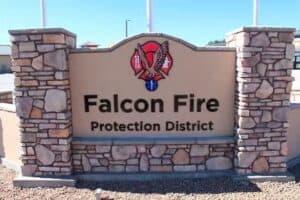Winter driving woesThe winter storm that moved through the area in mid-November caused headaches for many Falcon and Black Forest residents, especially during the evening commute Nov. 16. Heavy, wet snow and high winds created slick roads, deep drifts and whiteout conditions that caused motorists to slide into ditches and get stuck on hills.Falcon firefighters responding to a reported traffic accident in the north end of the fire district were delayed by cars stuck on Meridian Road, just north of Upriver Road. Meridian runs steadily uphill from Falcon, but the grade turns steeper just past Upriver; and some vehicles could not make it up the icy hill. Units responding from Black Forest reported a similar situation on hilly Hodgen Road. Fortunately, no injuries were reported in either the original accident or the multiple slide-offs, and plow crews were able to clear the roads so traffic could start moving again. However, this incident is a good reminder about the importance of being prepared for winter driving.Coloradoís weather can be severe and unpredictable at any time of year. In El Paso County, the mountains and the Palmer Divide, a ridge that extends roughly along the countyís northern border, can wreak havoc with weather and produce quite different conditions across the Pikes Peak region. During the Nov. 16-17 storm, neighborhoods such as Woodmen Hills and Meridian Ranch dealt with relatively small snow drifts, while residents living just 10 miles farther north had to dig out of drifts as high as 4 to 5 feet.If meteorologists are correct about El Nino spurring more intense winter storms, this storm could be just the beginning of a long and challenging season for the Pikes Peak region. Firefighters offer two pieces of advice for dealing with severe winter weather:
- Pay attention to weather forecasts and monitor current weather conditions. Knowing what the weather is doing or is expected to do is key to preparedness.
- Stay off the roads unless it is absolutely necessary to be out. This not only ensures the safety of everyone who must travel during storms, it also helps road crews and emergency responders do their jobs.
- Maintain vehicles in good working order.
- Keep the fuel tank at least half-full at all times.
- Ensure tires have good tread. Consider installing studded snow tires, or keep a set of tire chains or cables with the vehicle.
- Always clear ice and snow from windshields, side and rear windows, headlights, and taillights/turn signals before driving.
- Prepare a vehicle emergency kit (see sidebar for more information)
- Allow extra time for commuting in bad weather.
- Know alternate routes between home, work, and school.
- If stranded, stay with the vehicle.
- Ice scraper, shovel, and jumper cables
- Tow rope or chain
- Cat litter or sand for better tire traction
- First aid kit and extra medications
- Warm clothes including jacket, gloves, hat, socks and sturdy boots
- Blankets or sleeping bags
- A†fully charged cell phone and phone charger
- LED flashlights and extra batteries
- Multi-tool or pocket knife
- Food: Choose calorie-dense, non-perishable foods such as energy bars, nuts, granola and dried fruit, and rotate it out of the car every few weeks.
- Water for each person and pet in the vehicle
- AM/FM radio to listen to traffic reports and emergency messages
- Flares or reflective triangles
- Fluorescent distress flag




